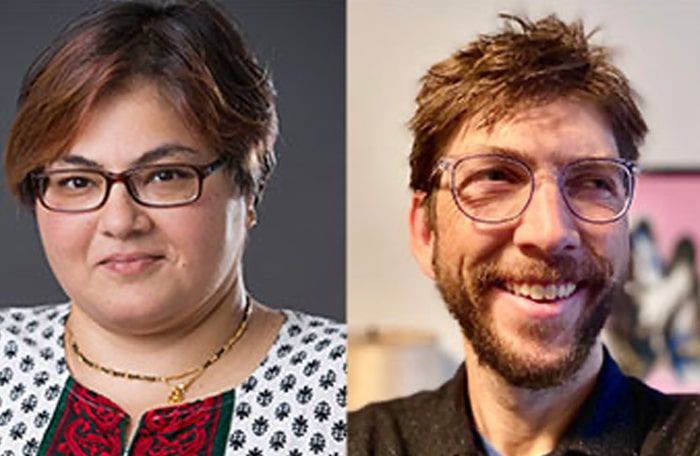Grant supports in-depth study of live neuron cells in real time.
Team will deploy pioneering technologies to advance understanding of protein aggregation, which is associated with ALS, Alzheimer’s, and frontotemporal dementia.
.
Hemali Phatnani, PhD, Director of the Center for Genomics of Neurodegenerative Disease (CGND) at the New York Genome Center (NYGC), and Liam Holt, PhD, Institute for Systems Genetics, Assistant Professor of Biochemistry and Molecular Pharmacology at NYU Grossman School of Medicine, are recipients of a Collaborative Pairs Pilot Project Award from the Chan Zuckerberg Initiative (CZI) through its CZI Neurodegeneration Challenge Network program.
The grant supports the researchers’ innovative project to study what changes occur inside brain cells during the progression of neurodegenerative diseases, including ALS, Alzheimer’s disease, and frontotemporal dementia. Protein aggregation is associated with all these diseases and has been the subject of intense study, yet the causes of this aggregation are still unknown. This new project will look inside cells to test if changes in molecular crowding are a cause of protein aggregation, or of “jamming,” which is the trapping of molecules such that they can’t effectively move. What is unique about the researchers’ approach is the utilization of a mix of emerging new technologies, including cutting-edge microscopy techniques, genetically encoded nanoparticles, and spatial transcriptomics, to monitor and probe these cellular events in live cells in real time.
“We are pleased that the Chan Zuckerberg Initiative has recognized the exciting potential of this cross-institutional, collaborative project, which uses multiple genomic modalities to study neuron cells,” said Tom Maniatis, PhD, NYGC’s Evnin Family Scientific Director and CEO. “The findings will generate new insights into neurodegenerative disease mechanisms.”
“We are very grateful to the Chan Zuckerberg Initiative for supporting this project, which brings together diverse ways of thinking and complementary expertise that can address important questions about cell biology through biophysical approaches,” said Dr. Phatnani, who also holds a joint appointment as Assistant Professor of Neurological Sciences in the Department of Neurology, Division of Neuromuscular Medicine, at Columbia University. “Through the lens of the latest genomic tools and technologies, we’re now able to explore the human neural system in ways that were unimaginable a few years ago.”
Through their award-winning project, “The Physical Biology of Neurodegeneration,” Drs. Phatnani and Holt will explore how features of cell types, genetics, signaling, and the mechanical environment of the cell come together to impact molecular crowding and aggregation in cells. The team will study how aggregation-prone proteins associated with neurodegenerative disease, for example, assemble into viscous liquid droplets in vitro, a process known as condensation; these droplets are hypothesized to be an intermediate to aggregates observed in postmortem central nervous system tissue. A key research focus will be testing the idea that overcrowding in the cell is a key factor that cause cellular components to start to stick together, leading to protein aggregate formation and disease onset.
The research team will make use of microscopy techniques, a specialty of Dr. Holt’s lab, to capture high-resolution images of the crowded interior of the cell, with nanoparticles illuminating this environment. The project will also deploy technologies such as spatial transcriptomics, the RNA-sequencing-focused mapping of intracellular relationships over space and time, which Dr. Phatnani and her lab, in a global collaboration, have used to develop a new atlas offering an unprecedented view of ALS disease progression, in a study published in Science last year.
“This project will leverage Dr. Phatnani’s deep understanding of the genetics of ALS with our lab’s approaches in biophysical analysis,” said Dr. Holt. “If you could shrink down to the size of a molecule and walk around inside a neuron, you’d find yourself in an overwhelmingly crowded place. We think that, when we age, for example, this crowd becomes even more dense, until the neuron begins to shut down. This project is an exciting opportunity to look inside neurons – and into this phenomenon – from a new perspective.”
CZI’s Neurodegeneration Challenge Network is an interdisciplinary collaborative network that brings together experimental scientists from diverse research fields, along with computational biologists and physicians, to understand the fundamental biology of neurodegenerative diseases and develop new strategies for treatment and prevention.
See also:
Could Overcrowded Cells Kickstart Neurodegeneration?
(Technology Networks, October 8, 2020)
CZI press release
Grantee website
CZI Medium post
CZI Science Twitter
